[ Appearance
][ Physiology
][ Homeplanet
& Places of Interest ][ Culture
][ History
][ Ships
]
[ Individuals
of Note ][ Mental
& Psionic disciplines ][ The
'Real' Vulcan ]
Appearance:
Externally similar to Humans except for pointed ears
and usually upward arched eyebrows.
Sometimes with a greenish complexion.
Physiology:
[ Circulatory
][ Digestive
][ Immune
][ Nervous
][ Reproductive
]
Vulcan, being an arid world with higher surface gravity and thinner
atmosphere than most class M worlds,
endows greater physical strength and endurance
to native-born and reared Vulcans in comparison to other
humanoids.
"Amok Time" [TOS]
Vulcans are three times stronger than Humans, according to Kassidy
Yates.
"Take me out the the Holosuite" [DS9]
Vulcans can function without sleep for more than two weeks.
"Muse" [VOY]
Vulcans don't sweat until the temperature reaches 350 degrees Kelvin
but the humidity also factors into
it.
"The Haunting of Deck Twelve" [VOY] (as told by Neelix)
Circulatory
System:
Vulcans have very different blood chemistry from
Bolians. A blood transfusion from a Vulcan to a Bolian
would be fatal for the
Bolian. "Prototype" [VOY]
Vulcan blood is distinctly green in colour,
due to the presence of copper instead of iron in their version of
hemoglobin.
"Obsession" [TOS]
Blood types - One possible blood type is T
negative, although this is rare even among Vulcans. Both
Spock and his father have T
negative blood types, but Spock's blood isn't true T negative blood; it
has
some human elements in
it. "Journey to Babel"
[TOS]
Heart - The Vulcan heart which
occupies roughly the same location as the human liver and is capable of
beating at several hundred
beats per minute.
"A Private Little War" [TOS]
Owing to the special
construction of the Vulcan heart, ordinary surgery on this organ is not
advisable.
A suro-genic open heart
procedure is recommended in such cases, although large amounts of blood
would be needed for the
operation.
"Journey to Babel" [TOS]
It might not be typical of all Vulcans, but Spock's
pulse was 242, and his blood pressure was almost nonexistent.
Digestive System:
The Vulcan digestive system is highly adaptable, so
that although many (human) foods may seem
unpalatable and have disagreeable smells, a Vulcan
should with time have no trouble digesting them.
"Unexpected" [ENT]
Immune System:
K cells - T'Pol's "Vulcan K cells" were able
to keep a mutagenic virus which was designed to rewrite the DNA
of the host in check.
Phlox was able to synthesize an antivirus from her genetic profile, but
needed an
"active sample of her DNA"
to complete it.
"Extinction" [ENT]
Reproductive
System:
Vulcan mating is surrounded by many rituals.
SEE: Culture,
Mating Rituals
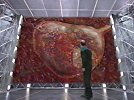 Voyager's EMH
created a "fascinating" twelve part holographic essay
Voyager's EMH
created a "fascinating" twelve part holographic essay
which he called 'Under the Skin: Humanoid Anatomy as
Art'.
It began with a "stunning" magnification
of the Vulcan reproductive gland.
"Nothing Human" [VOY]
Nervous System:
The Borg, whose designation for Vulcans is Species
3259, believe that the Vulcan's enlarged neocortex produces
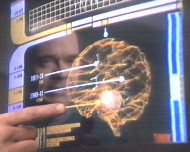 superior analytical
abilities. "The Raven" [VOY]
superior analytical
abilities. "The Raven" [VOY]
The Vulcan brain is in direct control of
most of the bodily functions,
acting as a control unit for many organs. Vulcans
have learned to gain
conscious control of many of these functions,
allowing them to
regulate their bodies to a high degree by simple
willpower.
When injured a Vulcan can go into a trance-like
state, a type of
self-induced hypnosis, using this ability to
concentrate all of his or her
energy onto repairing the injury. Most Vulcans
also have almost
complete control of automatic responses such as
generated by intense
pain.
The psychosuppression system responsible for
the cessation of emotions
is located in the mesiofrontal cortex of the
Vulcan brain. On rare
occasions, this area of the brain can be disrupted
(e.g. following a mind-meld with a violent individual.)
"Meld" [VOY]
Memory:
A repressed memory can be very dangerous to
Vulcans: the memory engrams in the dorsal region of his
hippocampus will be disrupted, causing
physical damage. In the case of a subject who is inhibiting a
traumatic memory, when it begins to resurface, it is
known as a T'lokan schism. Vulcan psychocognitive
research suggests that to treat such a case the
patient should initiate a mind-meld with a family member.
The aim is to bring the repressed memory into the
conscious mind. The family member acts as the
patient's "pyllora" during the meld - a
pyllora is a guide that helps the subject reconstruct the memory in
its entirety and objectify the experience, and they
help the subject reintegrate the memory into the
conscious mind; the pyllora is an observer and not a
participant, so no one else in the relived memory but
the patient will notice the pyllora's presence as
the patient relives the memory. The Doctor used a cortical
stimulator when Tuvok's memory engrams began to
destabilize and he was unable to break the mind-meld
between Tuvok and Janeway; he set it to emit thoron
radiation to bombard his telepathic cortex to try to
terminate the
meld.
"Flashback" [VOY]
Intentional repression of memories - SEE: Fullara
Senses:
Sight: The intensity of the Vulcan sun
caused the Vulcans to evolve a secondary eyelid to protect the retina.
This inner eyelid
involuntarily closes when the eye is exposed to extremely intense
light. Spock's inner-
eyelid protected him in 2267
against powerful light used in an experiment designed to eradicate the
Denevan neural
parasite.
"Operation - Annihilate!" [TOS]
Smell: Vulcan females have a
heightened sense of smell.
"Broken Bow" [ENT]
Vulcans think Humans smell
bad. They often use a nasal numbing agent when with humans for long
period of time.
"The Andorian Incident" [ENT]
Hearing: Vulcans have very sensitive ears.
Mental & Psionic Disciplines:
There are various examples of Vulcan telepathy and
mental control. They include: image generation,
meditation, emotional compulsion, psychic image
projection, the fullara, mind probe, mind meld,
mind link, fusion, transfer of the katra,
fal-tor-pan, mental shields, healing trance, and neuro-pressure.
SEE: Vulcan
Mental and Psionic Disciplines
Diseases:
Bendii Syndrome
- An incurable, untreatable, and fatal iillness that sometimes affects
Vulcans over
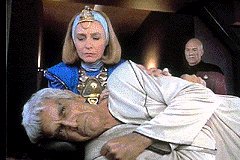 the age of 200. It is very
rare. So much so that by 2367
the age of 200. It is very
rare. So much so that by 2367
it has almost attained the status of a folk
tale. There has
not been a true case of the illness since before
2165.
Early symptoms include bursts of emotion, mostly
irrational anger. Eventually all emotional
control is lost.
In some instances the victim will unitentionally
project
these emotional outbursts telepathically onto others
at
random. A diagnosis is made by growing a
culture from
the tissue of the patient's metathalamus (a process
that
takes several days). The condition can be
temporarily stablized by mind-melding with another person.
Ambassador Sarek was afflicted with Bendii Syndrome
at the age of 202; the condition put his last
diplomatic mission in
jeopardy. "Sarek" [TNG]
Slightly more than a year later, Sarek eventually
succumbs completely to and died of Bendii Syndrome
at his home on Vulcan, in
2368.
"Unification" [TNG]
Chloriocytosis
- could be fatal to Vulcans. It haas a delayed effect on them.
Strobolin is the only known
cure but a synthesised drug can delay the effects of
the disease.
"The Pirates of Orion" [TAS]
Dramian auroral plague
- Vulcans are immune to this plaguue.
"Albatross" [TAS]
Fal-tor-voh
- The cure for a specific degenerative neurological disorder. It
involves mind-melding with
another compatible Vulcan
(members of one's family should be compatible). The disorder can
be
managed with medication for
years before the symptoms become serious. Early symptoms include
lapses in concentration,
accompanied by drops in neuropeptide levels.
"Endgame" [VOY]
Neutronic Gradient
- Vulcan physiology is sensitive to neuttronic gradients. SEE: Neutronic
storms .
"Fair Haven" [VOY]
Pa'nar
Syndrome - Pa'nar Syndrome is a transmissible disease, but
there's no pathogen. It is transmitted
through mind-melds.
The meld disrupts neuroelectric impulses in the midbrain, which leads
to the early
stages of the disease.
It is an incurable degeneration of the synaptic pathways that also
disrupts the
endocrine and immune
systems. One of the symptoms is a high level of neurolytic
enzymes. It could
very well lead to death if
not treated with supplemental medications. Because of the stigma
associated
with mind melds and since
the disease can only be contracted through one, its cure is not a
priority for
Vulcan medicine. But
even though there is no cure, enough is known about the disease to at
least slow
its progress. When
seeking the Vulcan research that had been done on the disease, Dr.
Phlox claimed
that it has similarities to
thymic sclerosis, a non-fatal Denobulan illness that Denobulans have
had very
little success
treating. T'Pol contracted the illness in 2151 when coerced into
a mind meld by Tolaris.
"Stigma" [ENT]
The idea that there's no
cure was a lie perpetrated by the High Command. Pa'nar has been
known
since Surak's time.
It's caused by melders who have been improperly trained. One with
great
experience can correct the
neurological imbalance.
"Kir'shara" [ENT]
T'lokan schism - SEE: Repressed Memorry.
Tuvan syndrome
- A degenerative, incurable neurologicall disease which affects mainly
Vulcans, Romulans,
and Rigellians. In the
very early stages, the patient's eyelids are slightly displaced, facial
muscles are
weakened, and respiration is
irregular. Loss of motor skills occurs in 10-15 years; life expectancy
is
20-25 years. In less than 5%
of cases, the disease can accelerate without warning.
"Inter Arma Enim Silent Leges" [DS9]
Drug Interactions:
Alcohol -
Vulcans are very susceptable to alcoholic intoxication. Vulcans
do not drink, except on rare
or special occasions,
usually related to diplomatic functions.
"Requiem for Methuselah" [TOS], "First Contact" [ST8],
"Carbon Creek" [ENT], "Cease Fire" [ENT]
Benjisidrine -
prescribed for malfunctions of a primaary heart valve (heart attacks).
"Journey to Babel" [TOS]
Caffeine
- has little effect on Vulcan physiology.
"Breaking the Ice" [ENT]
Stokaline - A
vitamin.
"By Any Other Name" [TOS]
Trellium-D -
Destroys the neural pathways and is lethal to Vulcans, although it
doesn't seem to affect
other
humanoids.
"Impulse" [ENT]
Places of
Interest:
Homeplanet
- The homeplanet of the Vulcan race is ccalled Vulcan
or Vulcanis.
 Vulcan is 16 light years
from Earth.
Vulcan is 16 light years
from Earth.
"Home" [ENT]
At Archer's question, "does the sky ever get this blue on
Vulcan?", T'Pol answers,
"occasionally".
"Strange New World" [ENT]
Much of the surface consists of large deserts or
mountain ranges.
It has a thinner atmosphere and generally hotter
climate than earth.
"Amok Time" [TOS]
Vulcan features huge wilderness preserves.
"Life Support" [DS9]
Vulcan has no
moon.
"The Man Trap" [TOS]
A large "moon" was clearly seen in the sky, so
perhaps this is actually a sister planet.
"Yesteryear" [TAS], "The Motion Picture" [ST1]
Capital/Major cities include:
ShiKahr -
Spock's
hometown
"Yesteryear" [TAS]
Vulcana Regar
- home to T'Shanik. "Coming of Age" [TNGG]
T'Pol attended the Regar Academy on Vulcan.
"Fallen Hero" [ENT]
ShirKahr -
Tolaris taught literature there.
"Fusion" [ENT]
A
Miranda class starship was named after this town.
"Tears of the Prophets" [DS9]
Other places of interest on Vulcan:
Gateway - The
location where Surak began his historic journey into the Forge.
"The Forge" [ENT]
Fire Plains -
Mentioned in classic Vulcan literature. SEE: Literature,
Clash on the Fire Plains , Falor's
Journey
Forge - A
hot desert with electrical sandstorms, called "sandfire", and
geomagnetic instabilities so severe
that technology
(communicators, scanners, or phase-pistols) will not function there --
one can't
even beam into it.
However, the dampening field only extends a few hundred meters above
the ground.
This allows Patrol craft to
fly over the forge, but their sensors can't see what's on the ground.
"The Forge" [ENT]
Worf suggested a hiking
expedition there, during Vulcan's summer, for his and Dax's delayed
honeymoon; Dax nixed the
idea.
"Yesteryear" [TAS], "Change of Heart" [DS9]
Gol
- A mountain range and a plateau that is associated with the
rituals of the Kohlinahr. The
Ruins of Gol are the
historically important abode of the Acolytes and the Vulcan Masters.
"The Motion Picture" [ST1]
SEE Also: Mt.
Seleya, Stone
of Gol.
Kir - Mentioned in the children's story Falor's Journey
Llangon Mountains
- Place where Spock performed his Kahs-wan ceremony.
"Yesteryear" [TAS]
K'tahl -
Tuvok had a holodeck program of the "Oracle of K'tahl" that was
tampered with (probably by
Tom or Harry playing a
practical joke on him).
"Live Long and Prosper" [VOY]
Raal - Mentioned in the children's story Falor's Journey
Seleya, Mount - Mt. Seleya is the easternmost peak in the Gol Mountain Range.
Tar'hana, Mount
- An active volcano that can be seen on the way down to T'Pol's
mother's house.
There are frequent
eruptions. "Home" [ENT]
T'Karath
Sanctuary - Located in the deep desert on the Forge.
"The Forge" [ENT], "The Awakening" [ENT], "Kir'Shara" [ENT]
ca 350: It was an
underground stronghold, a hideaway for the soldiers of one of the
factions during
the last Vulcan civil war
over two thousand years ago.
"Gambit, part 2" [TNG]
From 2152 to 2154 it was the
hideout for a faction known as the Syrrannites. Much of it was
destroyed in an effort to
wipe out the Syrrannites by an aerial bombardment.
"The Forge" [ENT], "The Awakening" [ENT], "Kir'Shara" [ENT]
As of 2370, the cavern had
been abandoned for centuries. There are remnants of decaying
Vulcan
artifacts lying around, and
some cracked and peeling glyphs on the walls. A crude stone altar
still
sits prominantly in the
room. The Vulcan Isolationist movement stored a piece of the Stone
of Gol
here which they had stolen
and this is where the whole was finally reassembled by T'Paal, one of
their operatives. She
was captured and the Stone retreived by Capt. Picard.
"Gambit, part 2" [TNG]
Temple of Amonak
- One of the most sacred temples on Vulccan.
"Hunters" [VOY]
Voroth Sea - Mentioned in the children's story Falor's Journey
Yaren, Lake
- Paris tells Tuvok that with the Varro environmental technology that
he could recreate
springtime on this Vulcan
lake in his quarters if he so desired.
"The Disease" [VOY]
Flora and Fauna:
Favinit plant - Foliage native to
Vulcan. In 2372, Starship Voyager's Lieutenant Tuvok created a rare
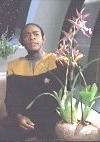 hybrid flower by grafting a
favinit plant with a South American orchid from
hybrid flower by grafting a
favinit plant with a South American orchid from
Earth. He doubted the graft would take, and
indeed the plant was sickly
at first, but after a few weeks both plants adapted
and became stronger
than either had been alone.
"Alliances" [VOY]
LeMatya - "Yesteryear" [TAS]
Nar'ru Vines - T'Les said
that the Nar'ru vines had bloomed early that year (2154), and that
since she
was retired, she had ample time to attend to them.
"Home" [ENT]
Orchids - Tuvok is a breeder of
Vulcan orchids; Neelix says that they make an exquisite salad when you
put a touch of baldoxic vinegar on them.
"Tattoo" [VOY]
Root Leaf - Dr. Phlox
keeps Vulcan root leaf in a container in Sickbay to feed one of his
animals.
"Exile" [ENT]
Sandworms - When Phlox is too
ill to leave sickbay, he has Hoshi bring some food for his
animals. Vulcan
sandworms are brought to feed to his bat.
"Regeneration" [ENT]
Sehlat - Vulcan teddy
bear.
"Journey to Babel" [TOS]; "Yesteryear" [TAS]
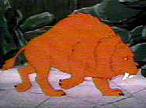 The way to evade them is to go to
higher ground... Sehlats don't climb.
The way to evade them is to go to
higher ground... Sehlats don't climb.
But they are very persistent creatures and will wait
for days
for their prey to come down before it loses interest
in it.
When T'Pol was a child she had a domesticated sehlat
for a
pet. The domesticated ones are slightly
smaller. Still, Vulcan
children are never late with their sehlat's dinner.
"The Forge" [ENT]
Off-planet places of interest:
P'Jem - A remote outpost on the
northern hemisphere of a planet that was only a few light years off
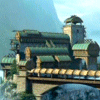 Enterprise's route of
exploration. It is an ancient spiritual retreat with a remote
Enterprise's route of
exploration. It is an ancient spiritual retreat with a remote
sanctuary for Kolinahr and peaceful
meditation. It is a place of quiet
contemplation. The monastery was founded by
Master Haadok, among
others over 3,000 years ago (ca 849 BC). The
monks there consider
technology a distraction so it isn't possible to
hail them. But that's not
a problem if one follows the protocols for visiting
P'Jem: Guests are
normally greeted by a Vulcan elder. One should
not speak to him or any
member of the Order unless spoken to first. If
they appear to be meditating, one should not approach
them or attempt to make conversation. Also the
guest should maintain quiet at all times, and refrain
from touching or disturbing any artifacts, relics,
or ornamentation. If one arrives at the time of
communal Kolinahr, its likely they will be turned
away. At the conclusion of their visit, guests will
be offered the Stone of J'kah, as a gesture of
salutation. One should, of course, accept it, then bow
slightly and observe a respectful silence for
approximately 5 seconds. The Vulcan elder will then
repeat a traditional litany passed down through the
generations: "Ishtaya kulah. Vestal ma etak J'kah."
In 2151, Captain Archer and Commander Tucker visited
the monastery only to be held prisoner by
Andorians who had already raided the place.
The Andorians were in search of a covert Vulcan sensor
array. There are catacombs beneath P'Jem,
where they bury their honored dead. The catacombs also
contain a Reliquary. Noone but a member of the
High Order is allowed to enter it. If anyone else
enters it, it is considered blasphemy.
Supposedly noone had entered it in years. However, the
hidden entrance to a Vulcan sensor array was found
in it after a fire fight. The concealed surveillence
site used a long-range sensor array to spy on the
Andorians in violation of treaty. Archer allowed the
Andorians to leave with scans taken of the facility.
"The Andorian Incident" [ENT]
The Andorians later bombarded the monastery on
P'Jem, but they gave enough warning so that
all of the monks and operatives could evacuate in
time.
"Shadows of P'Jem" [ENT]
Vulcanis Lunar Conlony - Tuvok's place of birth.
Culture:
[ Rites
of Passage ][ Mating
][ Religion
][ Art
][ Language
][ Food
and Drink ][ Government
]
Rites of Passage:
Vulcans learn to detach themselves from their emotions at a very early
age.
"Innoncence" [VOY]
Kahs-wan - The Kahs-wan ordeal was
a ritual by which young Vulcan males proved their manhood by
facing the dangers of the desert wilderness
alone. It can take from seven to eleven days or so, and may
kill the child. Vulcan year 8877, the 20th day of
Tasmeen was one month before Spock's kahswan,
which was described there as a test for Vulcan
males, as both a "maturity test" and "test of adulthood".
Failure is possible, but re-trys are
permitted. Spock's kahswan lasted for ten days on Vulcan's Forge
without food, water, or
weapons. "Yesteryear" [TAS]
T'Pol had "participated in the *kahswan*
ritual." She said, "I was taken to the desert and left to survive
for ten
days."
"Catwalk" [ENT]
Tal'oth - Tuvok stated that he
took part in the ritual of tal'oth wherein as a young child he survived
for four
months in the Vulcan desert with a ritual blade as
his only possession.
"Displaced" [VOY]
Mating Rituals:
Choosing a mate:
Choosing a mate is not done logically. Vulcans prefer to
not speak about this time, especially to out-worlders.
They try to keep their mating practices to
themselves, and shield the whole process with ritual and customs
shrouded in antiquity, apparently the price they
must pay for totally suppressing their natural emotions.
"Amok Time" [TOS]
There is nothing logical about Pon Farr. It is considered
inappropriate for one to involve themselves in
another's personal situation, so any interference in
how another is handling it is usually not only
unwelcome but also most likely counter-productive.
"Blood Fever" [VOY]
Vulcans usually have arranged marriages.
"Breaking the Ice" [ENT]
The Mating Bond: When
Vulcan children are about seven, by their parent's arrangement, a
future mate is
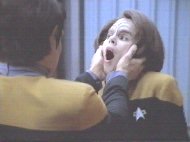 selected, and the two children are
joined in a ceremony which is considered
selected, and the two children are
joined in a ceremony which is considered
more than a betrothal, but less than a
wedding. One touches the other in
order to feel each other's thoughts. In this
way their minds are locked
together so that when the mated couple comes of age
at the proper time,
the telepathic bond between them would draw them
both together for the
marriage rituals. When they meet there is a
traditional greeting: the male
says "parted from me and never parted, never and
always touching and
touched. We meet at the appointed place." And
the female responds,
"parted from me and never parted, never and always
touching and touched. I await you."
"Amok Time" [TOS]
A Vulcan male which is attracted to a certain
female, may on occasion, initiate the telepathic mating bond
and not even be aware they have done so. It is
effected by holding the other's face tightly. The link
causes the mate to undergo all the symptoms of Pon
farr also. A Vulcan would have certain meditative
techniques at their disposal that would help them
control it. A non-Vulcan would likely be overcome
by
it.
"Blood Fever" [VOY]
Kunat-So'lik: If not
bonded as a child, or if the prospective parter has died or otherwise
become unavailable,
it is considered appropriate to choose
another. The Kunat-So'lik, is in human terms, a proposal of
marriage.
"Blood Fever" [VOY]
Pon farr ("time of
mating"):
A seven-year mating cycle is biologically inherent
in all Vulcans. At that time, the mating drive outweighs all
other motivations. The cycle is not easily
disturbed, but extreme feminine beauty (for the male Vulcan) is
always
disturbing.
"The Cloud Minders" [TOS]
It is called the Pon farr. It is a time when
when the adult Vulcan male experiences instinct and emotion
dominating over reason. It cannot be analysed by the
rational mind nor cured by conventional medicine.
Anyone who has experienced it understands that it
must simply be followed to its natural resolution. It is
a very traumatic experience for Vulcans, a proudly
logical species, having as it were, their logic ripped from
them, and their minds stripped from them. It
brings a madness which rips away their veneer of civilization.
"Amok Time" [TOS], "Blood Fever" [VOY]
Pon Farr is most commonly characterized by an
inability to control intense emotions that overcome them
during this time. It causes a neurochemical
imbalance in the brain, which will cause death if not relieved by
mating or ritual combat. Voyager's EMH was
concerned about the fluctuation in Vorik's serotonin levels and
about his cortical readings when he began the Pon
Farr. One reading would return to normal levels, then
another one would spike. It's chaotic, as if the
brain's regulatory system simply shuts down during this time.
"Amok Time" [TOS], "Blood Fever" [VOY]
The early stages of Pon Farr are accompanied by
headache, fever, respiratory distress, and tremors. The
 symptoms could be mistaken
for a virus (like the Tarkalean flu) but are
symptoms could be mistaken
for a virus (like the Tarkalean flu) but are
actually caused by a neuro-chemical imbalance.
In the early stages, the
urges and symptoms are controllable through
meditation combined with
medication (Voyager's EMH devised a treatment for
Tuvok which was
stored under file theta 12 alpha).
"Body and Soul"
[VOY]
How a Vulcan copes with the Pon Farr is considered a
test of his character.
His only alternatives during this time are the
Kunat-Kalifi or intensive
meditation. If he possesses enough discipline
to reach a point of psychological resolution then his
chemical imbalance should correct itself.
"Blood Fever" [VOY]
But the ancient drives are just too strong.
Eventually, they catch up with you, and Vulcans are driven
by forces they cannot control to return home and
take a wife or die, much like the giant eel-birds of
Regulus-5, or the salmon of Earth. "Amok Time"
[TOS]
And, unlike humans, the Vulcan libido increases with
time. But so too does the ability to control
or manage it - apparently through practice.
Tuvok, who had experienced several cycles in his life,
was able to pass through the pon farr successfully
with the aid of medication and a holographic image
of his wife,
T'Pel.
"Body and Soul" [VOY]
The similar attempt to resolve the pon farr through
the use of a holographic mate did not work for the
younger
Vorik.
"Blood Fever" [VOY]
The Wedding:
Kunat-kalifi ("marriage or challenge"):
A usually brief marriage ceremony. By tradition, the participants
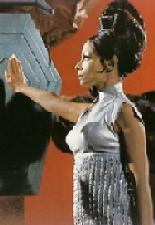 are accompanied by their closest
friends. It normally takes place on land set
are accompanied by their closest
friends. It normally takes place on land set
aside specially for this purpose by the family.
"Amok Time" [TOS]
The wedding is presided over by a priest or
priestess. As the
participants kneel facing one another, the
traditional litany said
by the priest goes: "This is the Vulcan
heart. This is the Vulcan
soul. This is our
way."
"Home" [ENT]
The partners exchange vows. (In Vulcan they
are very difficult for
humans to pronounce. It took weeks for Tucker
to learn them.)
"E2" [ENT]
A probe caused Spock to have a vision of a Vulcan
marriage drum, a ritual Vulcan instrument.
"The Lorelei Signal" [TAS]
If one partner does not wish to mate with the other,
they can choose
the Kal-i-fi during the ceremony. According to
Vulcan law and
customs, the Kal-i-fi is the only way to divorce a
mate.
"Amok Time" [TOS]
Kal-i-fi: In the
distant past, Vulcans killed to win their mates. The Kal-i-fi is
a hold-over from that time.
 It
is a ritual combat, an ancient tradition of fighting to the death for
one's
It
is a ritual combat, an ancient tradition of fighting to the death for
one's
mate. Once kal-i-fi is chosen, those who are
not direct participants in the
marriage are free to leave if they so wish.
The challenger has the right to
choose a champion to fight for them from those that
remain, or they can
fight on their own behalf. The challenger will
become the property of the
victor. Guards will monitor the fight and act
only if cowardice is seen.
Once kal-i-fi is chosen the male will go into a
state known as the Plak-tow.
"Amok Time"
[TOS], "Blood Fever" [VOY]
Plak-tow ("blood fever"):
The blood feels as if it were burning, and the eyes and heart feel as
if they were aflame.
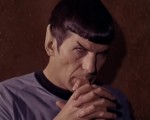 It becomes difficult, indeed nearly impossible to speak during this
time until one
It becomes difficult, indeed nearly impossible to speak during this
time until one
has passed through the combat for possession of
their mate. Acceptance of the
challenge is given. The Ritualized Combat
begins with the lirpa, and if both
survive that it continues with the ahn-wun.
Once the challenger is believed to
have been killed, the madness leaves and one returns
to their normal logical self.
"Amok Time" [TOS]
After marriage: It is
customary for a husband and wife to live together for one Vulcan year
immediately
following
marriage.
"Breaking the Ice" [ENT], "Home" [ENT]
Death:
Killing - It would be illogical to
kill without reason, but if there were a reason a Vulcan is quite
capable of killing--logically
and
efficiently.
"Journey to Babel" [TOS]
The natives of the planet Vulcan are not generally
predatory, but there have been exceptions.
"The Squire of Gothos" [TOS]
Katra - A
person's very essense; everything that is not of the body; everything
one was; everything one knew;
 one's living spirit. It is not
something that they speak of openly, but it is the
one's living spirit. It is not
something that they speak of openly, but it is the
Vulcan way when the body's end is near to mind meld
with the last one to be with
them, to entrust them with their katra. When
it is given to a person, they are
asked to bring the katra back to Vulcan with them to
ensure the deceased person's
"future". Both the one who is alive, and the
one who is not, will be in pain until
they return with the katra to Mount Seleya on Vulcan
because only there can both
find peace.
"The Search for Spock" [ST3], "Innocence" [VOY]
Fal-tor-pan, ("The
Refusion") - An ancient Vulcan ritual that reunites a
person's katra to the body if
it is reanimated. In 2285, it was used for the
first time in centuries.
"The Search for Spock" [ST3]
Suicide - Vulcans who reach a
certain infirmity with age sometimes practice ritual suicide.
"Death Wish" [VOY]
Funeral Dirge - At funerals
traditional songs are played. One such Vulcan Dirge begins, "O Starless
night
of boundless black..." Neelix stated that this
was one of the most cheerful Vulcan songs he could find.
"Tuvix" [VOY]
When the Doctor was making it hard for them to
sleep, Neelix says that he knows a Vulcan funeral dirge
they can
sing.
"Demon" [VOY]
Prayer - Tuvok to the dead Mr.
Suder: "I offer you a Vulcan prayer, Mr Suder. May your death bring
you the peace you never found in life."
"Basics" [VOY]
Philosophy and
Religion:
To be Vulcan means to adopt a philosophy, a way
of life which is logical and beneficial. One cannot
disregard that philosophy
merely for personal gain, no matter how important that gain might be.
"Journey to Babel" [TOS]
Integrity and Personal honor:
There is a well known saying
that Vulcans are incapable of lying. (While this saying is no
myth, it
may not be strictly
true.) Beyond the historic tradition of Vulcan loyalty, there is
also the combined
Romulan-Vulcan history of
obedience to duty.
"The Enterprise Incident" [TOS]
Vulcans never
bluff.
"The Doomsday Machine" [TOS]
Peace:
Vulcans believe peace should not depend on force. Vulcans do not
approve of violence.
"Journey to Babel" [TOS]
Vulcans worship peace above
all. "Return to Tomorrow" [TOS]
IDIC: Acronym
for Infinite Diversity in Infinite Combinations, a cornerstone of the
Vulcan
 philosophy. The most revered of
all Vulcan symbols. It symbolizes the glory
philosophy. The most revered of
all Vulcan symbols. It symbolizes the glory
of creation - which is in its infinite diversity,
and in the ways our
differences combine to create meaning and
beauty. The philosophy
teaches the tolerance of all peoples and ideas
to help create a society
that is greater than the sum of its own parts.
The symbol represents
this philosophy by combining variations in texture,
shape, and color.
It is a circle with a triangle of white and
yellow gold metals resting
upon each other and adorned with a white
jewel. It can be worn as an ornamental piece of jewelry
in either pin or pendant form. Spock wore an
IDIC medallion at a shipboard dinner in honor of
Dr. Jones. (The triangle-circle IDIC
pendant in this episode was designed by Gene Roddenberry
and has since been used as a Vulcan national
symbol.
"Is There in Truth no Beauty?" [TOS]
Mentioned by
T'Pol.
"The Andorian Incident" [ENT]
According to the unnamed Vulcan Master who tutored
teenaged Tuvok, it is called *kol-u-chang* -
"the cornerstone of our
beliefs" "Gravity"
[VOY]
The story of the IDIC? "Infinite Diversity in
Infinite Combination." Words that are a mere shadow
of its true meaning. Surak tells us that the
story of the IDIC has no end, but it begins at Mount Seleya.
"The Forge" [ENT]
Nome - An idea basic to the
Vulcan philosophy meaning "all". It refers to the combination of
a number
of things to make existence worthwhile. It
encompasses the concept of learning to be satisfied with
what we are. The Vulcans learned that
centuries before earth did.
"The Savage Curtain" [TOS]
Religious and Other Holidays:
Rumarie - A
Vulcan holiday. It was an ancient pagan festival celebrated by
feasting, orgies and other
hedonistic activities. Neelix says the
festival is full of barely clothed Vulcan men and women covered in
slippery Rillan grease chasing one another.
The Rumarie festival survived over a thousand years after the
time of Surak when Vulcans began to pursue the path
of pure logic.
"Meld" [VOY]
Kal Rekk - Neelix wishes Tuvok a
Happy Kal Rekk; Tuvok tells him that Kal Rekk is still 2 weeks off and
that it is a day of atonement, solitude, and
silence.
"Meld" [VOY]
Prayers - T'Pel tells Tuvok in her
message that she and his children have asked the priest at the temple
of Amonak to say prayers for Tuvok's safe return;
this temple is one of the most sacred temples on Vulcan.
"Hunters" [VOY]
Vulcan Spirituality: T'Pol
claims Vulcan spirituality is based on "logic and the pursuit of
clarity".
"Cold Front" [ENT]
Vulcan Consulate - place
on Earth where Tal-Shanar religious ceremonies are held.
"Cold Front" [ENT]
Vulcan Master - Elder mentors who guide aspirants through the Kohlinar ritual.
Kolinahr - "the Vulcan purging
of emotion."
The Order at the P'Jem Sanctuary practiced Kolinahr.
T'Pol warned Archer, "If we arrive at their time
of communal Kolinahr, it's likely we'll be turned
away... They are observing the final phase of the time
of Kolinahr. The Order must remain in silent
reflection throughout the lunar cycle. They are not to be
disturbed." The Elder told them, "Forgive the
disarray. Kolinahr encourages members of our order to
face their vestigial emotions. The
repercussions can sometimes be violent."
"The Andorian Incident" [ENT]
Janeway was present at the Kolinahr of Tuvok's
daughter.
"Fury" [VOY]
Stone of J'Kah - a
smooth black stone, roughly triangular, approximately 5-6 inches long,
which is kept in a
 small rectangular box of what
appeared to be carved brownish stone.
small rectangular box of what
appeared to be carved brownish stone.
T'Pol briefs Archer and Tucker before they leave
Enterprise:
"At the conclusion of our visit, we'll be offered
the Stone of
J'Kah as a gesture of salutation. Accept it, then
bow slightly
and observe a respectful silence for approximately
five seconds."
When the landing party is about to leave P'Jem, the
Vulcan
Elder extends the box to Archer, "This is the Stone
of J'Kah,
which represents a foundation of all we believe: a
life of order and control through logic." The Elder opens
the lid, Archer touches the stone, the Elder bows
his head and intones: "Ishtaya kulah. Vestal ma etak J'Kah."
Archer follows T'Pol's instructions: he bows his
head with the Elder and they observe a brief moment of
silence. The Elder explains to Archer: "It is a
traditional litany, passed down for generations."
"The Andorian Incident" [ENT]
V'tosh ka'tur ('Vulcans without logic')
- A name the elders give to anyone who ddisagrees with the
ancestral teachings and to embrace emotions.
But it's not entirely accurate - not all V'tosh ka'tur
believe they need to abandon logic to accomplish
this. Some groups just disagree with how Surak's
teachings are to be interpreted. They believe he
wanted them to master their emotions, and integrate
them into their lives, instead of rejecting
them. Many have tried to reintegrate their emotions and
Vulcan society would have you believe that all such
attempts have ended in failure, but one thing is
certain - that any such attempt is very
dangerous. History's shown that Vulcans who attempt to
embrace their emotions often revert to their primal
nature.
"Fusion" [ENT]
Art:
Dance: Vulcans only dance
when it's part of some tedious ceremony.
"Fusion" [ENT]
Vulcan Lute - A stringed musical
instrument. (Alternately referred to as the Vulcan lyrette
or the Vulcan harp.)
 The Vulcan lute
was first seen in "Charlie
X" [TOS]
The Vulcan lute
was first seen in "Charlie
X" [TOS]
Spock enjoyed playing this harplike instrument
during his off-duty hours.
"Charlie X" [TOS]
Spock used it to accompany Uhura's song "Beyond
Antares"
"The Conscience of the King" [TOS]
It also appeared in "Amok Time"
[TOS]
Spock joined in a folk session with some space
hippies.
"The Way to Eden" [TOS]
Spock plays 'Row, Row your boat' on it.
"The Final Frontier" [ST5]
A Vulcan lute was seen in the mirror Kira Nerys's
quarters.
"Through the Looking Glass" [DS9]
The Bothan caused Tuvok to hallucinate that the lute
he used to play for T'Pel was sitting right in
front of him. It was first referred to as
a "lute" in this episode.
"Persistence of Vision" [VOY]
Tuvok tells the children that this is a 5 stringed
instrument that is tuned on a diatonic scale; Tuvok's
youngest son is particularly found of it. (Tuvok
said his lute had five strings, but the actual prop had
12 strings.)
"Innocence" [VOY]
One of Tuvok's favorite pieces of music is the dirge-like "Chants of
the Monks of T'Panit", which is
selection 56-alpha in Voyager's Vulcan audio
file. Neelix played it for him in an attempt to jog his
memory.
"Riddles" [VOY]
Games:
Pleenok - A puzzle used to train
Vulcan children in primary logic. All 5 sides are triangles. It is
covered
in a pattern of black and white
triangles. [VOY]
Kaltoh - Kaltoh has been described
as "Vulcan chess", but in reality Kaltoh is to chess as chess is to
tic-tac-toe.
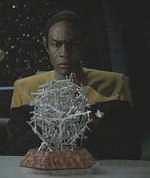 Tuvok had been playing since the
age of five, having been tutored by a kaltoh master.
Tuvok had been playing since the
age of five, having been tutored by a kaltoh master.
About 20 centimeters in diameter, kal-toh is a
construction of short metallic-crytal rods,
called t'an. They are joined in a
roughly spherical, seemingly chaotic manner.
The object of the game is to turn the jumble into a
perfect sphere. Each player takes a turn positioning
t'an and whoever gets the sphere to appear
first wins. If the piece is placed correctly, the
shape changes. If incorrectly, part of the structure
falls apart. Marayna attempted to create a
spatial balance by placing the t'an on opposite sides
of the Kal-toh; Tuvok says that this move is
common among novice Kal-toh players and it is a
strategy that will most certainly fail since Kal-toh
is not about striving for balance but about finding
the seeds of order even in the midst of profound
chaos. Nor is it about striving for beauty although
the structures formed can be beautiful. Tuvok
offers to teach Kim how to play Kal-toh.
"Alter Ego" [VOY]
Kim and Tuvok have been playing Kal-toh all night
when Seven finds them in the Mess Hall. Kim claims
the game, despite the fact that it is a game of
logic is very addictive. Seven makes the last move for Kim
since she is impatient for Kim to be free to assist
her on their diagnostic of the aft sensor array. She claims
that determining her impressive winning move was a
matter of Elementary Spatial Harmonics.
"Omega Directive" [VOY]
Kal-toh is as much a game of patience as it is of
logic. An experienced player will sometimes take several
hours to decide his next move, and in some cases,
even days may be necessary. Tuvok, suffering from a
lapse in concentration because of a neurological
disorder, was beaten by Icheb. When he made the final
move, he exclaimed "Kal-toh!" just as one would say
'checkmate' if they won the Earth-game of chess.
"Endgame" [ENT]
Literature:
T'Pol says that there are no ghost stories on
Vulcan.
"Strange New World" [ENT]
Tuvok says that Vulcan literature does not have any
demons in it; Chakotay says that that might account for its
popularity.
"Heroes and Demons" [VOY]
Before Tolaris joined the Vahklas, an obsolete ship
carrying V'tosh ka'tur, he taught literature at the prestigious
Shirkar Academy on
Vulcan. T'Pol was impressed.
"Fusion" [ENT]
"Clash
on the Fire Plains" - Tuvok owns a copy of this classic
proto-Vulcan drama in 23 parts (roles).
"Riddles" [VOY]
"Dictates of Poetics"
- Written by T'Hain of Vulcan; T'Hain saaid that a character's actions
flow from
his or her established
traits.
"Worst Case Scenario" [VOY]
"Falor's
Journey" - A tale of enlightenment in the form of a song
about Falor, a prosperous merchant
who went on a journey to gain greater
awareness. The song was a particular favorite of Tuvok's youngest
son. We heard Tuvok sing a fragment - there
are 348 verses in all...
"Through storms he crossed the Voroth
Sea to reach the clouded shores of Raal,
where old T'Para offered
truth. He traveled through the windswept
hills
and crossed the barren Fire
Plains, to find the silent monks of Kir.
Still unfulfilled, he journeyed
home, told stories of the lessons learned
and gained true wisdom by the giving..."
"Innocence" [VOY]
Language:
Spoken Language -
SEE: Vulcan
Dictionary
Written Language -
The Vulcans appear to have three written languages; two of which which
can be used separately or in
combination with each other.
The most common script on Vulcan is a vertically-written script, having
a central staff line on which
vertical spirals and horizontal dashes are
written, along with dots in various combinations. While no
official translations for these symbols exist,
it is speculated by some that the dots and dashes
represent consonants and the spirals are the
vowels. The script is written in vertical columns from
top to bottom, and left to right (like Mongolian).
when Trip reads T'Pol's letter:
Hoshi gives the decoded Vulcan transmission to Trip and tells him to
run it through the "Vulcan
 translation matrix". He walks over to
translation matrix". He walks over to
his Engineering work station, plugs
the cassette into a slot and turns on
his desktop computer. We see the
screen divided into two vertical
windows. The Vulcan original text
comes up on the left in columns
displaying left to right. When Trip
presses a button to activate the
translation matrix, notice that when
each column of the Vulcan text is
highlighted, a short English text block
quickly appears on the right half of the
screen separated by a blank line from
the previous one. It looks like each
Vulcan column corresponds to either a short English
paragraph or a very long, complex English sentence.
A somewhat larger view of the Vulcan text comes
earlier in the episode when T'Pol reads the letter on
the computer in her quarters. It's clear that
Vulcan is written in columns of uneven length, displaying
left to right on the
screen.
"Breaking the Ice" [ENT]
The second script written in the same direction consists of swirly
curved symbols (like Japanese hiragana).
It is assumed that these symbols are also phonetic,
perhaps syllabic or consonantal. The first two
scripts can be used seperately or in combination
with each other (as seen in T'Pol's letter from home).
When this is the case, the swirl-symbols accompany
the staff writing symbols as annotation written to
the right of the staff.
A third script consists of rectangular blocks cut into geometric
shapes. They have only ever been seen
on the hulls of some Vulcan ships and bear no
relation to the first two scripts.
Food and Drink:
The Promenade of station Deep Space 9 featured a restaurant
specializing in Vulcan cuisine.
"Indiscretion" [DS9]
Vulcans are vegetarian, and they don't touch their food with their
hands.
"Broken Bow" [ENT]
Brandy - Chakotay offered Tuvok
some Vulcan Brandy to toast the Maquis crew.
"Repression" [VOY]
Gespar - A type of fruit, sliced
and served for breakfast.
"Home" [ENT]
Mint - According to Perrin
(Sarek's wife), "Vulcans have some strange concoction they call
'mint'...
but you wouldn't recognize
it."
"Unification, part 1" [TNG]
Mocha - A "Vulcan Mocha" is the
drink that Cosimo serves Kim. Kim liked it extra sweet.
"Non Sequitor" [VOY]
Mollusks - Quark served Vulcan
mollusks to Fallit Kot during his stay on station Deep Space 9.
They are
best when sauteed in Rhombolian butter.
"Melora" [DS9]
Plomik (Also
spelled Plomeek) - A traditional Vulcan food.
In the mess hall, Crewman Cutler is sipping plomik broth.
She said Vulcan food was "interesting".
"Strange New World" [ENT]
T'Pol serves herself breakfast of a cloudy broth
with nothing in it and says, "Plomik broth is a traditional
morning meal on
Vulcan"
"Unexpected" [ENT]
T'Pol went to the galley for a bowl of plomik broth,
but acting chef Hoshi said she had no time for
"special
orders".
"Singularity" [ENT]
Archer bragged to a group of visiting Vulcan
physicians that T'Pol had taught Chef to make a
"pretty fair" plomik
soup.
"Stigma" [ENT]
Phlox has always thought that Chef's plomik broth
leaves something to be desired, but was afraid
to mention
it.
"Doctor's Orders" [ENT]
Nurse Chapel prepared a bowl of plomik soup
for Spock during his Pon Farr in 2267, but Spock
expressed his desire to be
left alone by throwing the bowl into the corridor. The soup was
orange
in
color.
"Amok Time" [TOS]
Neelix once made a version of plomeek soup for Tuvok
substituting in Delta Quadrant ingredients he
had at hand. Tuvok
said it was too spicy (like most of Neelix's cooking).
"Faces" [VOY]
Neelix again served Tuvok some plomik soup,
remarking that he had made it just the way Tuvok likes
it, "practically
tasteless".
"Body and Soul" [VOY]
Pok Tar - a Vulcan dish Archer
ordered prepared especially for Capt. Vanik on T'Pol's recommendation.
"Breaking the Ice" [ENT]
Spice tea - Hot beverage,
available from replicators on the U.S.S. Voyager. Tuovok and
Janeway have
Vulcan spice tea while discussing making an alliance
with the Kazon.
"Alliances" [VOY]
Port - Intoxicating beverage.
Quark offered some Vulcan port to Sakonna when beginning business
negotiations.
 Quark said that the green
drink was three centuries old and very expensive. It was in a
tall
Quark said that the green
drink was three centuries old and very expensive. It was in a
tall
bottle with a label in vertically-written Vulcan. (The
bottle was even a little dusty, which
may mean that Vulcan port isn't very popular with
any of the Humans, Cardassians,
Klingons, Ferengi, Bajorans, etc. who visited his
bar over the years!)
"The Maquis, part 1" [DS9]
Vulcans don't normally drink alcohol but on special
occasions do make exceptions.
"Requiem for Methuselah" [TOS], "First Contact" [ST8],
"Carbon Creek" [ENT], "Cease Fire" [ENT]
Rules of Conduct and Laws:
Vulcan protocols - When Archer
insists on boarding the Axanar vessel, T'Pol says there were "a number
of
protocols we haven't
tried." "Fight or
Flight" [ENT]
T'Pol stiffly suggests they follow Vulcan Protocols,
which dictate sending automated probes to the surface;
if the planet proves to be
Minshara-class ("suitable for humanoid life", explains Sato), they'd
next
conduct a geophysical scan
from orbit; in total, 6-7 days.
"Strange New World" [ENT]
It is a Vulcan protocol, but not Starfleet, to delay
contact until a civilization achieves warp travel.
"Civilization" [ENT]
Vulcan Bill of Rights - Document
that guarantees the fundamental personal freedoms of every Vulcan
citizen.
"The Maquis, Part I" [DS9]
Institutions and
Government Entities:
Consulate
- For some rreason, the Vulcans seem to
call their embassies consulates. The Vulcan
Consulate on Earth is a
compound in Sausalito, near San Francisco.
Diplomatic Service - Ambassador V'Lar has spent 94 years in
the Vulcan Diplomatic Service.
"Fallen Hero" [ENT]
Vulcan ambassadors wear a
formal hooded cloak with a shiny lining. On the right lapel is a
vertical
line of Vulcan glyphs; the top
one resembles a question mark (?). Soval wears such a cloak and the
glyphs can be seen in ENT
"Shadows of P'Jem".
In TNG "Sarek", Sarek's formal
cloak and his aides' suits had such a line of glyphs, topped by the
"question mark". V'Lar wore
such a cloak, but without the line of glyphs in ENT "Fallen Hero".
Possibly the glyphs mean
"diplomatic service"? Notable members of the Diplomatic Service
are:
Sakkath, Sarek, Soval, T'Pel
and V'Lar.
High Command- Archer refers to
the Vulcan High Command.
"Strange New World" [ENT]
The commanding body of the Vulcan Space Service (or
the Vulcan government?). Archer dreaded
asking the High Command for help in 2151, imagining
they would send a Surak-class ship to tow
Enterprise back to
base.
"Silent Enemy" [ENT]
Ambassador Soval announced the cancellation of joint
Earth-Vulcan fleet operations by the High
Command as a result of the Andorian destruction of
the P'Jem Sanctuary.
"Shadows of P'Jem" [ENT]
Tavin of the Vahklas told Archer that he felt the
High Command "looking over their shoulder" from
time to time, monitoring his group of V'tosh katur.
Kov is the son of a high-ranking minister on the
High
Command.
"Fusion" [ENT]
The High Command asked Starfleet to send the
Enterprise to ferry Ambassador V'Lar from the planet
Mazar to a rendezvous with the Vulcan cruiser
Sh'Raan.
"Fallen Hero" [ENT]
Lorot was a subaltern in the Vulcan High Command
assimilated by the Borg (at Wolf 359?).
"Infinite Regress" [VOY]
The High Command used the destruction of the
Paraagan colony in 2152 to persuade Starfleet to cancel
their deep space explorations for twenty years,
sending a ship to pick up T'Pol and Phlox.
"Shockwave" [ENT]
Institute of Defensive Arts -
Learning institution located on Vulcan. Tuvok taught archery science
for several years at the Vulcan Institute of
Defensive Arts.
"Basics, Part 2" [VOY]
Isolationist movement - Small
but growing group of separatists on Vulcan during the late 24th
century.
The isolationists believed that contact with alien
civilizations had polluted their culture and destroyed
Vulcan purity. They advocated the total isolation of
Vulcan from the rest of the galaxy and the eradication
of all alien influences from their planet.
Tallera was a member of the isolationist group, who, in 2370, tried
to reassemble the ancient Stone of Gol for use in
furthering the movement's goals.
"Gambit, Part 2" [TNG]
Science Academy -
Institute of higher learning on planet Vulcan.
Spock chose to apply to Starfleet in 2249 rather
than stay on his homeworld and study at the academy.
That decision was the cause of a rift between Spock
and his father, Sarek, that lasted for 18 years.
"Journey to Babel" [TOS]
The director of the academy from 2354 to 2369 was
subspace theoretician Dr. T'Pan.
"Suspicions" [TNG]
Science Council - T'Pol
was inspired to "choose a life course", leading her to the Science
Council after
meeting Ambassador V'Lar at the Second Ka'Tann
Conference.
"Fallen Hero" [ENT]
Science Directorate - T'Pol
claims that the "Vulcan Science Directorate" has studied time travel
extensively, and has found no evidence that it
exists or can exist.
"Cold Front" [ENT], "Shockwave" [ENT]
Security Force, V'Shar - Vulcan
Security Force (governmental organization), headed by Security-
Minister
Satok.
"Gambit. part 2" [TNG]
In 2151, Archer exposed the long-range Vulcan sensor
array underneath the P'Jem Sanctuary used by
Vulcan intelligence for
spying on the Andorians.
"The Andorian Incident" [ENT]
P'Jem was subsequently destroyed by the Andorians,
who gave the monks and intelligence staff three
hours warning to vacate
before they attacked.
"Shadows of P'Jem" [ENT]
Space Central - Before assuming
orbit around Vulcan one usually must obtain permission from "Vulcan
Space
Central.
"Amok Time" [TOS]
Space Program - The Vulcan
military space service. Capt. Vanik had served in the Vulcan Space
Program for 76 years, the last 15 of which in
command of the Ti'Mur.
"Breaking the Ice" [ENT]
History:
SEE: Vulcan
History
Personal Weapons and Fighting Skills:
Psionic Weapons:
The Stone of Gol
- An ancient Vulcan artifact that dated from the Time of
Awakening. Long thought
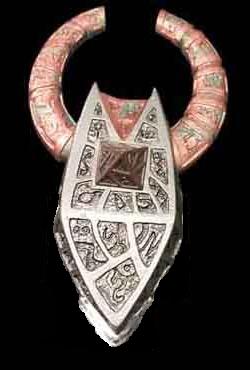 to be mere legend, the
stone was a psionic resonator that operated
to be mere legend, the
stone was a psionic resonator that operated
by focusing and amplifying telepathic energy.
It enabled its bearer
to kill by telepathy, turning an opponent's own
violent thoughts
and emotions against him. To operate it, the
user need only hold
the weapon, aim it at a single living target, and
mentally activate it
with a single projective telepathic thought.
The Stone of Gol was
actually three interlocking artifacts covered with
ancient Vulcan
glyphs and symbols. These writings mostly warned of
death and
destruction to anyone who opposed the resonator, but
one hiero-
glyph on the anterior shows an intricate series of
circles and lines
and another more abstract drawing of a Vulcan heroic
figure... the
symbols for the Vulcan god of War and the god of
Death. Typically
the gods of War and Death would appear alone on an
artifact, they
would never be combined with a third glyph.
But on a third inter-
locking piece of the resonator they are separated by
the symbol for
Peace. The hieroglyph's message was a warning
that the resonator's power can be overcome by peace.
The only obvious protection against the weapon is to
clear your mind of all aggressive thoughts.
According to legend, the stone of Gol was destroyed
by the gods when the Vulcan people found the
way of peace. In actuality, the stone had been
dismantled, with one piece placed in a Vulcan museum.
In 2369, extremists from the Vulcan isolationist
movement stole the first fragment and hired
Arctus Baran to find the two remaining pieces. Baran
raided numerous Romulan archaeological
sites throughout the quadrant, and by early 2370,
had located the artifacts. Baran's employers were
prevented from using the device, and later, Vulcan
authorities vowed that they would destroy the
three pieces of the resonator once and for all to
prevent it's future misuse.
"Gambit, part 2" [TNG]
Conventional Melee Weapons:
Lirpa - An ancient weapon. It
is a staff-like shaft about 160 cm long with curved blades on one end,
and
 a
heavy bludgeon on the other.
Both it and the ahn-woon are
a
heavy bludgeon on the other.
Both it and the ahn-woon are
traditionally used during the kunat kalifi.
"Amok Time" [TOS]
Ahn-woon - A weapon made of a
single leather strip about 6 feet long. It sometimes has a small
leaden
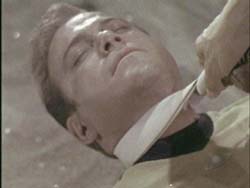 weight at one end. It can
be used as a whip or a noose. Both it and the lirpa are
weight at one end. It can
be used as a whip or a noose. Both it and the lirpa are
traditionally used during the kunat kalifi.
"Amok Time" [TOS]
Guard's Axe (unofficially called the
"Trillpa") - It is the standard Vulcan sword, consiisting of a
long, straight,
 double-edged blade and a hilt
with a single-edged crescent-shaped blade
double-edged blade and a hilt
with a single-edged crescent-shaped blade
for a guard. The weapon could be used by a
scythe-guard for parrying and blocking.
"Amok Time" [TOS]
Bow and Arrows (unofficially called
"khaiya") - Archery was and is used on Vulcan.&nbssp; Tuvok
taught archery
science for several years at the Vulcan Institute of
Defensive Arts.
"The Savage Curtain" [TOS], "Basics, part 2" [VOY]
Martial Arts and Fighting techniques:
Suus Mahna - A Vulcan martial art
that takes years to master. T'Pol appears to be proficient in it.
"Marauders" [ENT]
Navorkot - A simple evasive
maneuver in the martial art form Suus Mahna. It is not difficult
to learn.
The Navorkot involves using ducking, side stepping,
and somersalts to dodge your opponent.
"Marauders" [ENT]
The Vulcan nerve pinch - A
defensive move which instantly and nonviolently causes unconsiousness
in
an individual. Pressure is applied to certain
nerves and blood vessels at the base of the neck using one's
fingers.
It caused a contraction of muscles which resulted in
the 'evil-Kirk' firing the phaser he had in his hand.
This is the first time we get to see the
nerve pinch used. The Famous Spock
Nerve Pinch (as it became known to the show's production staff) was
invented by actor Leonard Nimoy, who devised it
because he thought Spock would not stoop to rendering an
opponent unconscious with a karate chop.
"The Enemy Within" [TOS] : 1 pinch
Sulu who had been infected with the Psi 2000 virus
had to be subdued. Kirk tells Spock that he would like him to
teach
that to him
sometime.
"The Naked Time" [TOS] : 1 pinch
"Dagger of the Mind" : 1 pinch
"The Menagerie, Part I" : 2 pinches
"Tomorrow Is Yesterday" : 2 pinches
"The Return of the Archons" : 1 pinch
"A Taste of Armageddon" : 1 pinch
"Space Seed" : 1 pinch
"Errand of Mercy" : 1 pinch
"City On the Edge of Forever" : 2 pinches
"Operation - Annihilate!" : 3 pinches
"Catspaw" : 1 pinch
"Friday's Child" : 1 pinch
"Wolf in the Fold" : 1 pinch
"I, Mudd" : 1 pinch
"Bread and Circuses" : 2 pinches
"A Piece of the Action" : 4 pinches
"Patterns of Force" : 3 pinches
"The Ultimate Computer" : 1 pinch
"The Omega Glory" : 2 pinches
"Assignment: Earth" : 2 pinches
"The Enterprise Incident" : 1 pinch
"And the Children Shall Lead" : 1 pinch
"The Empath" : 1 pinch
"The Tholian Web" : 1 pinch
"For the World Is Hollow..." : 1 pinch
"Day of the Dove" : 2 pinches
"Whom Gods Destroy" : 3 pinches
"The Mark of Gideon" : 1 pinch
"The Way To Eden" : 2 pinches
"Turnabout Intruder" : 2 pinches
"Conspiracy" [TNG] : 1 pinch
"Starship Mine" : 1 pinch
Data was able to master the technique.
1
pinch
"Unification, Part II" [TNG]
"The Maquis, Part I" [DS9] : 1 pinch
"Paradise Lost" [DS9] : 1 pinch
The Vulcan nerve pinch can cause trauma to the
trapezius nerve bundle.
1
pinch
"Cathexis" [VOY]
"Flashback" : 1 pinch
"Warlord" : 1 pinch
"Displaced" : 1 pinch
"Raven" : 1 pinch
"In the Flesh" : 1 pinch
"Gravity" : 1 pinch
"Star Trek I: The Motion Picture" : 1 pinch
"Star Trek II: The Wrath of Khan" : 1 pinch
"Star Trek III: The Search for Spock" : 2
pinches
"Star Trek IV: The Voyage Home" : 1 pinch
The technique appears to work on nearly all humanoid
species and several nonhumanoids as well (including horses).
1
pinch
"The Final Frontier" [ST5]
T'Pol pinches
Mayweather.
"Strange New World" [ENT]: 1 pinch
T'Pol was unsure the pinch would work on Denobulans,
but it did.
"Singularity" [ENT]: 1 pinch
Very few non-Vulcans have been able to master the
nerve pinch. Spock tried, unsuccessfully, to teach the nerve pinch
to Kirk.
Vulcan Death Grip - There is no
such thing as a Vulcan death grip. There does exist however a
"grip" which
temporarily stuns the person into an unconscious
state which can be mistaken for death. Spock used it to
appear to have killed Kirk during their spy mission
aboard a Romulan vessel in 2268, and then he claimed
that it was the Vulcan death grip. This ruse
allowed Kirk to escape back to the Enterprise.
"The Enterprise Incident" [TOS]
Tal-shaya - An ancient form of
execution once used on Vulcan. Pressure is applied to a specific area
on the base
of the victim's neck, causing it to snap and cause
instantaneous death.
"Journey to Babel" [TOS]
----------------------------------------------------